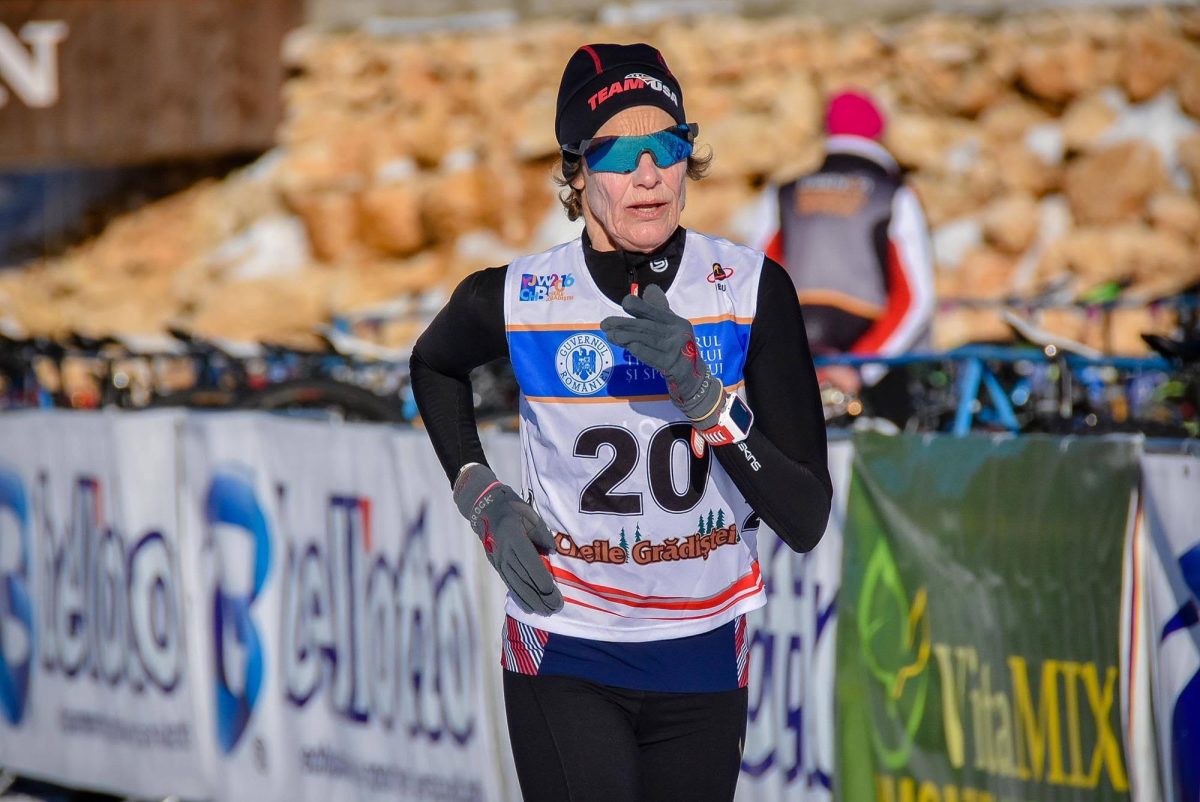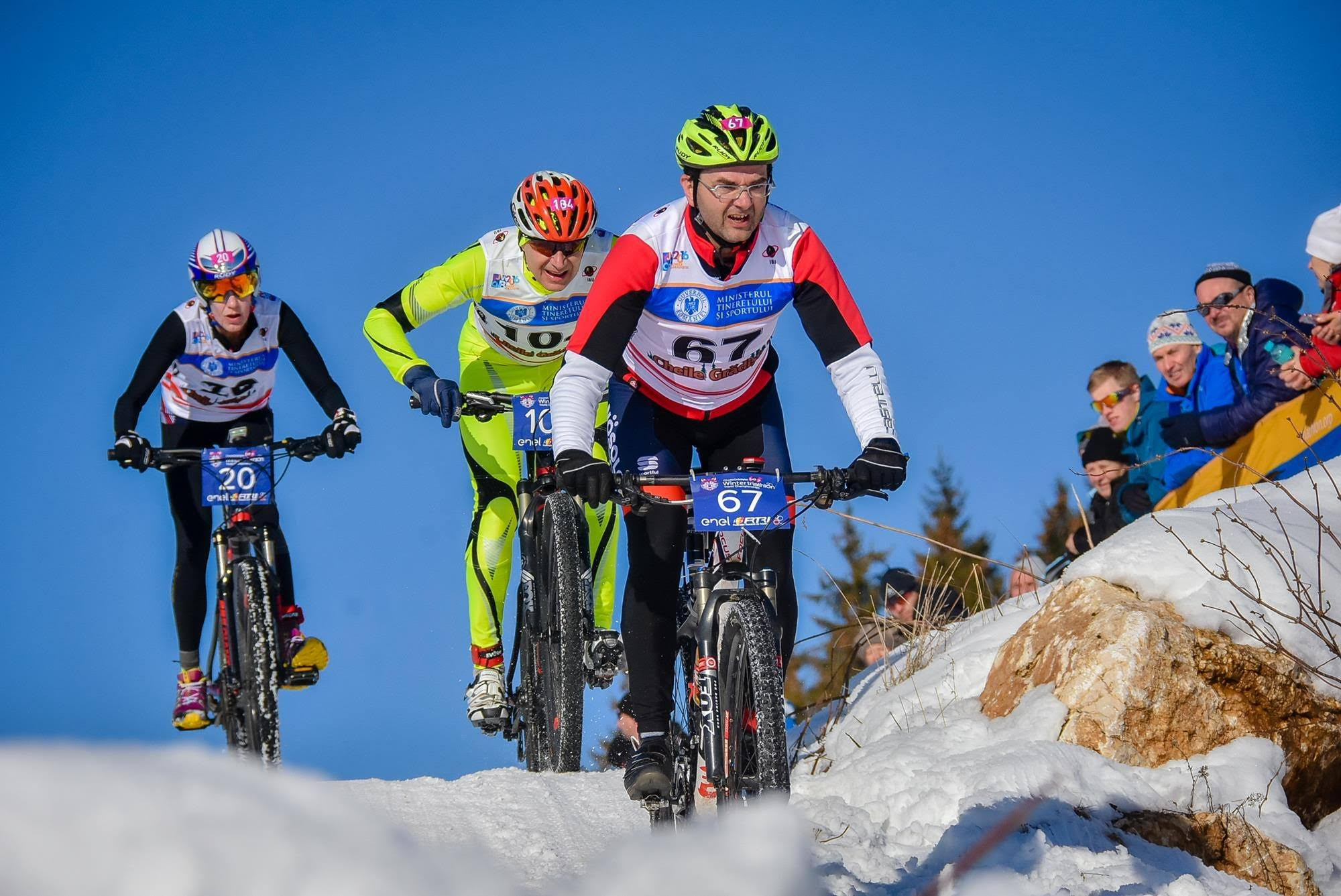Sheri Schrock has been a multisport athlete, competing in events featuring more than one sport, for 13 years. The 64-year-old diving and mountain biking coach has competed at the International Triathlon Union Duathlon World Championships, and as a Minnesota resident, is a lifelong cross-country skier. So in 2016, when she learned there would be a winter triathlon in St. Paul, just three hours from her home, she jumped at the opportunity to compete in the cross-country ski-run-bike event.
“I went right out a bought a fat-tire bike,” Schrock says. “I was attracted to the race for the fun factor and the opportunity to learn some new bike-handling skills.”
Schrock loved the experience of racing on snow in run-bike-ski events so much that she continued entering winter triathlons and qualified at the 2017 USA Winter Triathlon Championships in St. Paul, Minnesota. This led to an appearance at the ITU World Championships in Romania last year, where she won her age group. Winter triathlon is much smaller than its summer counterpart. In 2018, for instance, there were just 67 finishers at the Winter Triathlon National Championships, and anyone could enter. Compare this to the USAT Triathlon National Championships last summer, which had nearly 5,000 competitors between the sprint and international distances, and competitors had to earn a spot in the events. What winter triathlon lacks in popularity, however, it makes up for with its alternative to the traditional swim-bike-run format.
For her part, Schrock loves that competing on snow allows her to experience a wide variety of conditions. “Winter triathlons are totally unpredictable, so you have a new challenge every time,” she says. “You might wake up to a foot of new snow overnight, or ice, and you have to tackle whatever is thrown your way.”
While winter multisport events come in all shapes and sizes, involving any number of sports, winter triathlon is the most traditional format. Caryn Maconi, communications manager for USA Triathlon, says that a typical winter race will consist of a 5k to 9k run, 10k to 15k bike, and 8k to 12k cross-country ski. “The events are generally on groomed Nordic ski trails, so competitors don’t need a big investment in specific gear to race,” she says. “You’ll see a wide variety of shoes, bikes and skis.”
In Maconi’s experience, most U.S. athletes in the winter version of the sport fall into a masters age group—those over 40—and already have a multisport background. Because the sport is small, even at the national championship level there are no qualifying standards. “We tend to see a lot of older athletes who find cross-country skiing a great way to stay in shape,” she explains. “This year we sent nine age-group athletes to worlds, and all of them were over 50.”
Schrock says that winter triathlon is extremely popular in Europe, but lesser-known here in the United States. “It’s a lower-key sport here than traditional triathlon or duathlon, so you don’t need to put in as much sport-specific training,” she says. “That said, having good fat-tire skills can help you power through and gain some spots in your age group.”

For Sheri Schrock, running in the snow is part of the experience. (Photo Credit: Radu Cristi)
Mike Kloser, 59, counts among his storied athletic career—he’s also a four-time adventure racing world champ, a three-time Eco Challenge champion, a world mountain bike champion among others—two national winter championship titles and several high placings at the world championships. He says that part of his winning formula was swapping out the time he dedicated to particular sports from winter to summer. “I mostly dropped swimming in the winter and replaced it with more running and skiing,” he says.
Like Schrock, Kloser says the laid-back vibe that most competitors bring to winter triathlons is a nice respite for most type-A athletes. “It’s definitely more casual than traditional triathlon,” he says. “But if you’re serious about it, it’s worthwhile to do your homework on the specific sports and put in some training.”
For those who live somewhere without much snow for training, Kloser recommends a couple of hacks: “You can ride your bike on sandy surfaces, and for running, strap on some snowshoes and run in grass,” he says. “The key to the bike is getting into an easy gear and riding at a high cadence because you’ll have so much resistance from snow.”
Not all winter multisport races follow the run-bike-ski format. Ed Harvey, a 43-year old finance professional from New Hampshire, is a regular at the state’s annual Tuckerman Inferno Pentathlon: a run, kayak, bike, hike and downhill ski race that totals up to about 36 miles, held each April. “I love this race because it brings all my athletic disciplines together,” he says. “It’s an organized way to do something dangerous you wouldn’t try alone.”
Conditions vary widely from year to year at Tuckerman, and athletes need to be prepared for a little bit of everything. “The organizers determine the final course the day before based on snow and water conditions,” Harvey explains.
Harvey preps for the race each year with some single-discipline races and training in each of the sports. “I spend much of my winter on skis or snowshoes,” he explains, “but I’m not on the bike during the colder months.”
Come April race day, Harvey is ready to put it all together. “It’s just fun to participate in an event like this,” he says, “and see if you can do it.”
The variety, laid-back atmosphere and fun factor are clear components of winter multisport and the obvious draw that brings people back, year after year. If it whets your appetite for adventure, Schrock says go for it: “There’s a big range in skill-set out there, so no one should feel intimidated. It’s a great opportunity to try something new.”
What You Need to Enter a Winter Triathlon
One of the pros of entering a winter event is that you don’t need a ton of extra gear beyond what you might already have if you’re a multisport athlete. However, there are a few items that can make training and racing winter events much easier if you want to be competitive:
- Cross-country skis—traditional will do just fine, but at the more competitive level, skate skis can be an advantage.
- Cross-country spikes, trail shoes, or some sort of traction device for your running shoes. In some races, snowshoes are the norm.
- Fat-tire or mountain bike with wide tires.
- Cold-weather technical clothing, like tights, gloves and hats.
Ready to race? Find sanctioned winter triathlon race listings at USA Triathlon.
